I am in a PC bang in Mokpo. The 5-hour bus ride down started in Seoul, where there is now no snow, passed through a region where there is still a few inches of snow on the ground, and then finished in Mokpo, where there is only a little bit of snow. Odd. The TV on board the bus showed several programs, including an episode of Doctor Who dubbed in Korean (the first sign I've ever seen that Doctor Who has made any inroads into Korea).
I'll upload some photos when I get back to Seoul, but I've spent this day hiking up the mountain that dominated Mokpo (with some spectacular views from the top) and walking along the seaside. It's not really open sea, since I look out to sea and I see islands rather than the far-off horizon, but it's salt water. And it's only the second time I've seen the sea in Korea.
Sunday, December 31, 2006
Friday, December 29, 2006
Weekend Plan
I have another three-day weekend so I thought I might travel again. I've never been to Jeollanamdo - South Jeolla Province - and I'm thinking about going to Mokpo by bus. Mokpo is a mid-sized port city, and it sounds more interesting for a short casual visit than Gwangju, the capital and biggest city in the province.
So I ran the idea past some of my classes and I had one class tell me it was a silly idea. None of them have ever been to Mokpo, but they told me it was not a great place to visit and I shouldn't go there. Mokpo apparently has a bit of a reputation for crime and gangs.
Another of my classes said that Mokpo is a perfectly fine city and I shouldn't let anti-Jeolla regional sentiment deter me. (Technically Jeonju is part of Jeolla too, but it's up north. Mokpo is Deep Jeolla.) I read this after and it helped me see my students' comments in perspective. I'm going to try to go there by bus tomorrow - the 5+ hour bus ride will help be time to relax and read - and I'll take pictures.
So I ran the idea past some of my classes and I had one class tell me it was a silly idea. None of them have ever been to Mokpo, but they told me it was not a great place to visit and I shouldn't go there. Mokpo apparently has a bit of a reputation for crime and gangs.
Another of my classes said that Mokpo is a perfectly fine city and I shouldn't let anti-Jeolla regional sentiment deter me. (Technically Jeonju is part of Jeolla too, but it's up north. Mokpo is Deep Jeolla.) I read this after and it helped me see my students' comments in perspective. I'm going to try to go there by bus tomorrow - the 5+ hour bus ride will help be time to relax and read - and I'll take pictures.
Monday, December 25, 2006
More on Jeonju
Overall I liked Jeonju more than I expected. People told me before I went that Jeonju was a small city, almost more like a large town, but I never got that impression. My hotel was located about 2km from the parts of Jeonju of historical interest, but while I walked I never got the feeling that I was transversing most of the city. The reference books say that Jeonju has over half a million people. I could believe it. There were numerous apartment buildings off in the distance in every direction. As my bus left the city it went through entire teeming commercial districts that I never visited. Jeonju's not as big as Seoul, but it's a decent-sized city.
I regret not taking more time to explore rural provincial Korea. I liked the intercity bus terminal in Jeonju. It was a dismally lit, slightly grimy building, very long and very busy, with buses continually departing for the small cities and towns of southwestern Korea. It was lined with maybe a dozen cheap places to eat, and the whole terminal smelled of cheap street food, particularly the big pot of bundaegi that one vendor kept ready. It's the kind of place I don't get to go to often in Seoul, where the major train and bus terminals tend to be more modern.
The most famous culinary aspect of Jeonju is its bibimbap. Bibimbap is cooked rice, raw vegetables, spicy sauce, a fried egg, and sometimes meat, that you stir together in a bowl. I'm afraid to say that I had bibimbap in two different locations in Jeonju, and in each location it tasted basically the same as bibimbap in Seoul. I don't know if I chose the wrong places to try the famous bibimbap, or if I am just too culinarily unrefined to tell the difference. What I had wasn't bad; it just wasn't special.
I regret not taking more time to explore rural provincial Korea. I liked the intercity bus terminal in Jeonju. It was a dismally lit, slightly grimy building, very long and very busy, with buses continually departing for the small cities and towns of southwestern Korea. It was lined with maybe a dozen cheap places to eat, and the whole terminal smelled of cheap street food, particularly the big pot of bundaegi that one vendor kept ready. It's the kind of place I don't get to go to often in Seoul, where the major train and bus terminals tend to be more modern.
The most famous culinary aspect of Jeonju is its bibimbap. Bibimbap is cooked rice, raw vegetables, spicy sauce, a fried egg, and sometimes meat, that you stir together in a bowl. I'm afraid to say that I had bibimbap in two different locations in Jeonju, and in each location it tasted basically the same as bibimbap in Seoul. I don't know if I chose the wrong places to try the famous bibimbap, or if I am just too culinarily unrefined to tell the difference. What I had wasn't bad; it just wasn't special.
Random Jeonju Pics
More pictures I took wandering around the touristy crafts-selling part of Jeonju. (Whatever happened to the street photography class I took? These pictures are just of buildings. Of things. There aren't any people.)




 And the regular downtown area of Jeonju:
And the regular downtown area of Jeonju:

 I like the look of this building.
I like the look of this building.
 And - Merry Christmas.
And - Merry Christmas.




 And the regular downtown area of Jeonju:
And the regular downtown area of Jeonju:
 I like the look of this building.
I like the look of this building. And - Merry Christmas.
And - Merry Christmas.
Jeonju Christmas
 I went down to Jeonju this weekend. Jeonju (often spelled Chonju) is the capital of Jeollabukdo (or Chollabukdo, or North Cholla Province) and is a modest tourist attraction due to having popular food, some well-preserved architecture and being the capital of a province with several well-known parks.
I went down to Jeonju this weekend. Jeonju (often spelled Chonju) is the capital of Jeollabukdo (or Chollabukdo, or North Cholla Province) and is a modest tourist attraction due to having popular food, some well-preserved architecture and being the capital of a province with several well-known parks.SATURDAY
 Saturday evening, after taking the bus down from Seoul and getting a room in the first cheap hotel I laid eyes upon, I wandered about the city.
Saturday evening, after taking the bus down from Seoul and getting a room in the first cheap hotel I laid eyes upon, I wandered about the city. The writing on that monument says something like "1,000-Year Jeonju Entering an Even Greater Future". I saw the same slogan in several places around the city.
The writing on that monument says something like "1,000-Year Jeonju Entering an Even Greater Future". I saw the same slogan in several places around the city. Jeondong Catholic Church is a handy reference point when you're in the older part of the city.
Jeondong Catholic Church is a handy reference point when you're in the older part of the city. According to Lonely Planet, it was built on the site of the martyrdom of Korean Catholics in 1781 and again in 1801.
According to Lonely Planet, it was built on the site of the martyrdom of Korean Catholics in 1781 and again in 1801. Jeonju City Hall.
Jeonju City Hall. This is the hotel I stayed in. That's right, above the 7-11. It doesn't look like much, but it's as cheap as any place I've ever stayed at in this country - 20,000 won/night - and the room was pretty decent and clean.
This is the hotel I stayed in. That's right, above the 7-11. It doesn't look like much, but it's as cheap as any place I've ever stayed at in this country - 20,000 won/night - and the room was pretty decent and clean.SUNDAY
 Can anyone guess what this gigantic, magnificent building is? It's a wedding hall. It's a place you pay to get married in.
Can anyone guess what this gigantic, magnificent building is? It's a wedding hall. It's a place you pay to get married in. Pungnammun, the last surviving bit of Jeonju's city wall.
Pungnammun, the last surviving bit of Jeonju's city wall. Jeonju's main historical distinction is that it was the home base of the Joseon Dynasty, which ruled Korea for more than 500 years. Gyeonggijeon is a family shrine, and contains pictures of dynastic founder King Taejo and 6 later kings, and is also a very nice place to walk around. Like a free city park with lots of trees and benches.
Jeonju's main historical distinction is that it was the home base of the Joseon Dynasty, which ruled Korea for more than 500 years. Gyeonggijeon is a family shrine, and contains pictures of dynastic founder King Taejo and 6 later kings, and is also a very nice place to walk around. Like a free city park with lots of trees and benches. The view from a hill.
The view from a hill. You see cartoon mascots everywhere in Korea - even the War Memorial in Seoul has its cute cartoon characters that adorn the brochures. These two guys can be seen everywhere in the touristy area in Jeonju.
You see cartoon mascots everywhere in Korea - even the War Memorial in Seoul has its cute cartoon characters that adorn the brochures. These two guys can be seen everywhere in the touristy area in Jeonju. Hanbyeokdang Pavilion. It dates from 1404 and was a peaceful refuge for poets.
Hanbyeokdang Pavilion. It dates from 1404 and was a peaceful refuge for poets. The view from the pavilion. Lonely Planet admits that with the bridge it's not as peaceful as it once was.
The view from the pavilion. Lonely Planet admits that with the bridge it's not as peaceful as it once was. There are small restaurants along the river. Most of them have little or no seating inside; they provide large meals to be shared outside during summer months. They were open but they didn't seem very busy.
There are small restaurants along the river. Most of them have little or no seating inside; they provide large meals to be shared outside during summer months. They were open but they didn't seem very busy. Tied up near the river (and he wasn't the only one - there was another, much bigger dog chained nearby). They both seemed well-fed and not neglected.
Tied up near the river (and he wasn't the only one - there was another, much bigger dog chained nearby). They both seemed well-fed and not neglected.
Saturday, December 16, 2006
Snow!
Snow! It's 11:30 on Saturday evening, I am in my apartment safe and sound, and it is snowing heavily. And it's sticking.
In fact, it's snowing heavily enough that I can't even see the nearby apartment buildings. Normally I'd be able to see many dozens of apartment lights from my window. Tonight they are dim blurs through the snow.
In fact, it's snowing heavily enough that I can't even see the nearby apartment buildings. Normally I'd be able to see many dozens of apartment lights from my window. Tonight they are dim blurs through the snow.
A Tree
Monday, December 11, 2006
The Hammering Man wears a Hat
Saturday, December 09, 2006
Cheonggyecheon II
 There are stepping stones.
There are stepping stones. That's a footbridge.
That's a footbridge. Stream-side architecture.
Stream-side architecture. Cheonggyecheon residents.
Cheonggyecheon residents. More Cheonggyecheon scenes...
More Cheonggyecheon scenes...


 This is the official end of Cheonggyecheon. It merges with another stream, Jungnangcheon, and flows for another couple of kilometers until it reaches the Han River.
This is the official end of Cheonggyecheon. It merges with another stream, Jungnangcheon, and flows for another couple of kilometers until it reaches the Han River. Around here the duck population skyrockets.
Around here the duck population skyrockets. I finally ended up here (my feet didn't hurt, but it was getting colder). I admire how Ungbong Station is resisting the new official Romanization (in which it would be Eungbong), which is now about six years old. I suspect that's because it's on the Jungang Line, which always seems to be the victim of neglect compared with the numbered subway lines.
I finally ended up here (my feet didn't hurt, but it was getting colder). I admire how Ungbong Station is resisting the new official Romanization (in which it would be Eungbong), which is now about six years old. I suspect that's because it's on the Jungang Line, which always seems to be the victim of neglect compared with the numbered subway lines.
Cheonggyecheon I
Today I tried again to walk along Cheonggyecheon all the way to the Han River. I didn't get all the way to the river, but I did keep going past the point where it's technically no longer Cheonggyecheon. Does that count? Cheonggyecheon entrance, near Dongmyo. When I took this picture I had just consumed a too-large amount of spiced garlicky mutton at Himalaya nearby. I'm going to walk east, away from Seoul's downtown area (and the phantasmagorically colored snail shell sculpture where Cheonggyecheon begins that everybody seems to hate).
Cheonggyecheon entrance, near Dongmyo. When I took this picture I had just consumed a too-large amount of spiced garlicky mutton at Himalaya nearby. I'm going to walk east, away from Seoul's downtown area (and the phantasmagorically colored snail shell sculpture where Cheonggyecheon begins that everybody seems to hate).
 Quite a nice ultra-lanscaped place to walk.
Quite a nice ultra-lanscaped place to walk.
 Those statues guarding the bridge are usually associated with Jejudo, the island to mainland Korea's south. But Koreans from all over see them as a sort of cultural symbol.
Those statues guarding the bridge are usually associated with Jejudo, the island to mainland Korea's south. But Koreans from all over see them as a sort of cultural symbol.
 There used to be an elevated roadway here, and some of the supports are still up.
There used to be an elevated roadway here, and some of the supports are still up.
 It's like you're looking at ancient ruins.
It's like you're looking at ancient ruins.

 Cheonggyecheon entrance, near Dongmyo. When I took this picture I had just consumed a too-large amount of spiced garlicky mutton at Himalaya nearby. I'm going to walk east, away from Seoul's downtown area (and the phantasmagorically colored snail shell sculpture where Cheonggyecheon begins that everybody seems to hate).
Cheonggyecheon entrance, near Dongmyo. When I took this picture I had just consumed a too-large amount of spiced garlicky mutton at Himalaya nearby. I'm going to walk east, away from Seoul's downtown area (and the phantasmagorically colored snail shell sculpture where Cheonggyecheon begins that everybody seems to hate). Quite a nice ultra-lanscaped place to walk.
Quite a nice ultra-lanscaped place to walk. Those statues guarding the bridge are usually associated with Jejudo, the island to mainland Korea's south. But Koreans from all over see them as a sort of cultural symbol.
Those statues guarding the bridge are usually associated with Jejudo, the island to mainland Korea's south. But Koreans from all over see them as a sort of cultural symbol. There used to be an elevated roadway here, and some of the supports are still up.
There used to be an elevated roadway here, and some of the supports are still up. It's like you're looking at ancient ruins.
It's like you're looking at ancient ruins.
Wednesday, December 06, 2006
Me and 漢字
I bought some new notebooks for studying Chinese characters. These are meant specifically for beginners' study of Chinese characters. That's right, it's some kind of teddy bear studying 漢字 on the cover. That shows you what kind of age group they expect to be learning Chinese characters for the first time. I have some catching up to do.
That's right, it's some kind of teddy bear studying 漢字 on the cover. That shows you what kind of age group they expect to be learning Chinese characters for the first time. I have some catching up to do.
 That's right, it's some kind of teddy bear studying 漢字 on the cover. That shows you what kind of age group they expect to be learning Chinese characters for the first time. I have some catching up to do.
That's right, it's some kind of teddy bear studying 漢字 on the cover. That shows you what kind of age group they expect to be learning Chinese characters for the first time. I have some catching up to do.
They're moving Gwanghwamun!
 I took that photo about two weeks ago. Now they've totally encased Gwanghwamun - soon-to-be-demolished Gwanghwamun - behind obaque scaffolding, as you can see here.
I took that photo about two weeks ago. Now they've totally encased Gwanghwamun - soon-to-be-demolished Gwanghwamun - behind obaque scaffolding, as you can see here.I suppose it's not right to miss the old gate. It wasn't all that old, after all - unlike Namdaemun which dates from the 1400s, and Dongdaemun which was last rebuilt in the 1800s, Gwanghwamun in its present form is only a few decades old.
Now that they are tearing down and rebuilding the gate, they are taking this opportunity to remodel that whole area, which I welcome. The intersection at the northern end of Sejong-no can be a pain to cross on foot. Pedestrian access can only be improved, in my opinion. A few weeks ago someone from the city government came to my workplace and had me fill out a survey on what kind of improvements foreign residents wanted to see. I am under absolutely no delusion that my opinion will make a difference, but I picked my favorite plan for the remodeled street out of the four choices I was shown. Assuming it doesn't completely mess up traffic, I figure it will probably be an improvement.
Monday, December 04, 2006
Heungbu and Nolbu
In Korean class last week we discussed "Heungbu & Nolbu". It's probably the single most well-known Korean folk story - every Korean knows the story, and it's part of basic cultural literacy here.
Heungbu and Nolbu were brothers. Older brother Nolbu was greedy and cruel. Younger brother Heungbu was kind and good-hearted. They both found wives with personalities to match their own. They inherited a fortune from their father, but Nolbu had Heungbu and his family kicked off the family estate.
Heungbu, his wife, and their many children settled some distance away and began a marginal existence. Heungbu could not grow enough food for his family, and when he came to his brother's house to beg for food, Nolbu's wife chased him away. Even as his children neared starvation, Heungbu stayed peaceful and law-abiding.
One day a huge snake attacked a family of swallows that had made their nest in the eaves of Heungbu's house. Heungbu chased the snake away, but not before a baby swallow fell from the nest and broke its leg. Heungbu carefully set the bird's leg and bandaged it with cloth, and the bird rejoined its family.
The swallows flew south that fall. When they returned the following spring, a swallow approached Heungbu and gave him a seed. Heungbu planted the seed near his home, and throughout the summer he and his family watched as a tree grew and sprouted giant melons. When fall came and the melons were fully ripe, Heungbu and his wife cut one open, only to have precious jewels and gold coins spill out. Another melon yielded magical builders, who built Heungbu and his family a grand palace.
Word of Heungbu's wealth spread around, and eventually Nolbu heard of it. He summoned his brother and demanded to know how he had become rich. Heungbu - who apparently held no hard feelings for his older brother - told Nolbu the whole story. Nolbu listened, at first with disbelief, and then with growing excitement.
The next spring, the swallows returned, and one family made their nest in the eaves of Nolbu's house. Nolbu impatiently waited for a snake to come along and attack them; when no snake appeared, he deliberately broke a baby sparrow's leg, then mended it and let it rejoin its family. The swallows flew south that winter, and Nolbu confidently waited for them to return with his fortune.
The next spring the swallows returned, and one of them presented Nolbu with a seed. Nolbu planted the seed, and he and his wife impatiently waited for the magic melons to ripen. When they judged the melons to be ripe enough, Nolbu and his wife split one open with a saw. Immediately a gang of bandits emerged from the melon; they stole all of Nolbu's belongings and torched his house.
Suddenly broke, Nolbu and his wife came to Heungbu's house and begged for his forgiveness. Heungbu happily let them stay in his house, where they lived peacefully ever after.
--
Obviously, fairy-tale justice is meted out at the end of this story. Heungbu is rich and powerful, and Nolbu is at his mercy. As the Yonsei University Korean textbook points out though, Heungbu is basically passive. At no point does it even enter his mind to protest Nolbu's treatment, and he never takes any action against his older brother. He lives a completely subservient life, and is rewarded for it.
Of course, Heungbu is the hero and we are supposed to cheer for him. But there's a reason why there's a chain restaurant with locations across Korea called Nolbu's. Nobody would expect Heungbu's poverty-stricken household to give guests much to eat, but you can always count on Nolbu for a good meal.
Heungbu and Nolbu were brothers. Older brother Nolbu was greedy and cruel. Younger brother Heungbu was kind and good-hearted. They both found wives with personalities to match their own. They inherited a fortune from their father, but Nolbu had Heungbu and his family kicked off the family estate.
Heungbu, his wife, and their many children settled some distance away and began a marginal existence. Heungbu could not grow enough food for his family, and when he came to his brother's house to beg for food, Nolbu's wife chased him away. Even as his children neared starvation, Heungbu stayed peaceful and law-abiding.
One day a huge snake attacked a family of swallows that had made their nest in the eaves of Heungbu's house. Heungbu chased the snake away, but not before a baby swallow fell from the nest and broke its leg. Heungbu carefully set the bird's leg and bandaged it with cloth, and the bird rejoined its family.
The swallows flew south that fall. When they returned the following spring, a swallow approached Heungbu and gave him a seed. Heungbu planted the seed near his home, and throughout the summer he and his family watched as a tree grew and sprouted giant melons. When fall came and the melons were fully ripe, Heungbu and his wife cut one open, only to have precious jewels and gold coins spill out. Another melon yielded magical builders, who built Heungbu and his family a grand palace.
Word of Heungbu's wealth spread around, and eventually Nolbu heard of it. He summoned his brother and demanded to know how he had become rich. Heungbu - who apparently held no hard feelings for his older brother - told Nolbu the whole story. Nolbu listened, at first with disbelief, and then with growing excitement.
The next spring, the swallows returned, and one family made their nest in the eaves of Nolbu's house. Nolbu impatiently waited for a snake to come along and attack them; when no snake appeared, he deliberately broke a baby sparrow's leg, then mended it and let it rejoin its family. The swallows flew south that winter, and Nolbu confidently waited for them to return with his fortune.
The next spring the swallows returned, and one of them presented Nolbu with a seed. Nolbu planted the seed, and he and his wife impatiently waited for the magic melons to ripen. When they judged the melons to be ripe enough, Nolbu and his wife split one open with a saw. Immediately a gang of bandits emerged from the melon; they stole all of Nolbu's belongings and torched his house.
Suddenly broke, Nolbu and his wife came to Heungbu's house and begged for his forgiveness. Heungbu happily let them stay in his house, where they lived peacefully ever after.
--
Obviously, fairy-tale justice is meted out at the end of this story. Heungbu is rich and powerful, and Nolbu is at his mercy. As the Yonsei University Korean textbook points out though, Heungbu is basically passive. At no point does it even enter his mind to protest Nolbu's treatment, and he never takes any action against his older brother. He lives a completely subservient life, and is rewarded for it.
Of course, Heungbu is the hero and we are supposed to cheer for him. But there's a reason why there's a chain restaurant with locations across Korea called Nolbu's. Nobody would expect Heungbu's poverty-stricken household to give guests much to eat, but you can always count on Nolbu for a good meal.
Sunday, November 26, 2006
East of Gyeongbokgung
I really like the neighborhood east of Gyeongbok Palace and north of Insadong. I am not certain what it is officially called, but it's full of little shops, Italian restaurants, and art galleries. It draws a very artsy-type crowd on weekends. After wandering around for a while, I gradually realized that there are no chain stores. A Starbucks would not look out of place, but there isn't even a 7-11 or a Family Mart. Even the "No-Parking" sign in the lower right is oddly classy.
Even the "No-Parking" sign in the lower right is oddly classy.
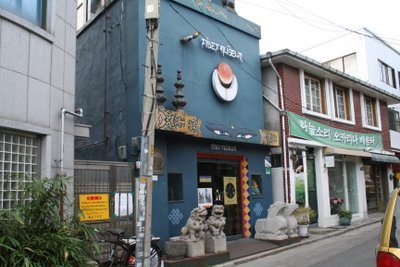 The Tibet Museum. I don't know what's inside.
The Tibet Museum. I don't know what's inside.
 A sculpture store.
A sculpture store.
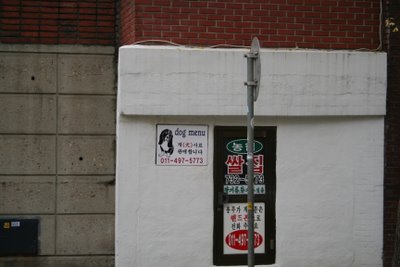 I'm pretty sure that means they have a menu for dogs. But you know Westerners who walk by are going to make fun of it, right?
I'm pretty sure that means they have a menu for dogs. But you know Westerners who walk by are going to make fun of it, right?
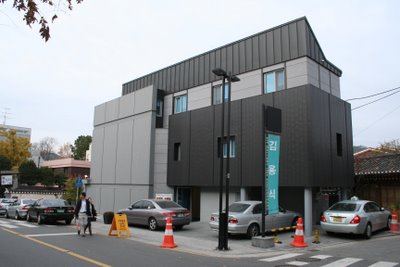 This isn't quite traditional Korean architecture. But there are plenty of buildings like this coexisting with more traditional-looking buildings here.
This isn't quite traditional Korean architecture. But there are plenty of buildings like this coexisting with more traditional-looking buildings here.
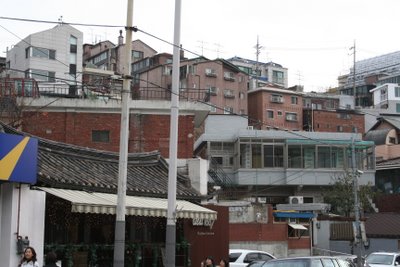 Seoul is a hilly city, and you often see buildings only accessible by side roads that rise steeply up hills.
Seoul is a hilly city, and you often see buildings only accessible by side roads that rise steeply up hills.
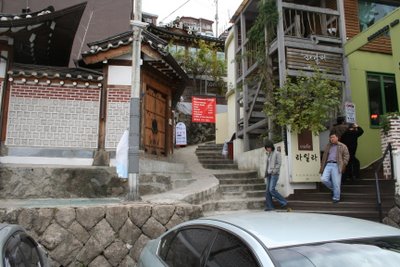 That said, it may be picturesque, but I'd hate to have to live in a wheelchair in this country.
That said, it may be picturesque, but I'd hate to have to live in a wheelchair in this country.
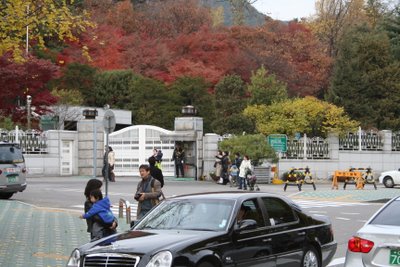 Take a look at that foliage. Something Highly Official is behind that gate (note the armed guard); I'm not sure what it is but the President's official residence is nearby.
Take a look at that foliage. Something Highly Official is behind that gate (note the armed guard); I'm not sure what it is but the President's official residence is nearby.
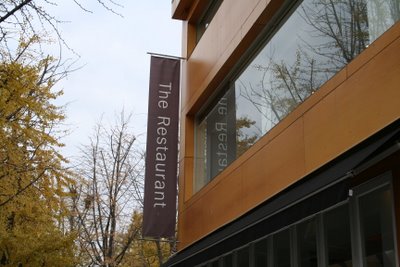 This is The Restaurant. If you're ever in Seoul and you're wondering where the restaurant is, well, here it is.
This is The Restaurant. If you're ever in Seoul and you're wondering where the restaurant is, well, here it is.
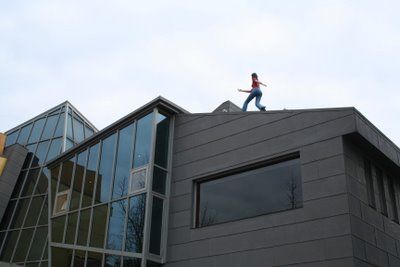 Next door to The Restaurant is this building with what looks like a statue of a woman bowling on the roof. She's either bowling or running - I can't tell. I figure it's a step up from the naked scowling pigman rooftop sculpture I saw in Suwon.
Next door to The Restaurant is this building with what looks like a statue of a woman bowling on the roof. She's either bowling or running - I can't tell. I figure it's a step up from the naked scowling pigman rooftop sculpture I saw in Suwon.
 Even the "No-Parking" sign in the lower right is oddly classy.
Even the "No-Parking" sign in the lower right is oddly classy. The Tibet Museum. I don't know what's inside.
The Tibet Museum. I don't know what's inside. A sculpture store.
A sculpture store. I'm pretty sure that means they have a menu for dogs. But you know Westerners who walk by are going to make fun of it, right?
I'm pretty sure that means they have a menu for dogs. But you know Westerners who walk by are going to make fun of it, right? This isn't quite traditional Korean architecture. But there are plenty of buildings like this coexisting with more traditional-looking buildings here.
This isn't quite traditional Korean architecture. But there are plenty of buildings like this coexisting with more traditional-looking buildings here. Seoul is a hilly city, and you often see buildings only accessible by side roads that rise steeply up hills.
Seoul is a hilly city, and you often see buildings only accessible by side roads that rise steeply up hills. That said, it may be picturesque, but I'd hate to have to live in a wheelchair in this country.
That said, it may be picturesque, but I'd hate to have to live in a wheelchair in this country. Take a look at that foliage. Something Highly Official is behind that gate (note the armed guard); I'm not sure what it is but the President's official residence is nearby.
Take a look at that foliage. Something Highly Official is behind that gate (note the armed guard); I'm not sure what it is but the President's official residence is nearby. This is The Restaurant. If you're ever in Seoul and you're wondering where the restaurant is, well, here it is.
This is The Restaurant. If you're ever in Seoul and you're wondering where the restaurant is, well, here it is. Next door to The Restaurant is this building with what looks like a statue of a woman bowling on the roof. She's either bowling or running - I can't tell. I figure it's a step up from the naked scowling pigman rooftop sculpture I saw in Suwon.
Next door to The Restaurant is this building with what looks like a statue of a woman bowling on the roof. She's either bowling or running - I can't tell. I figure it's a step up from the naked scowling pigman rooftop sculpture I saw in Suwon.
Subscribe to:
Posts (Atom)

